Hello hello friends scientists! Today I show you a small post about some scientific terms that I learned in my ecology classroom and we will learn their use in the field! the terms to be explained in this post are samples per transect and per quadrant! we are going to capture some insects like butterflies and we will conclude by dissecting them! enjoy the post!🐛🐌🦋🐛
Olá amigos cientistas! Hoje mostro a vocês um pequeno post sobre alguns termos científicos que aprendi na minha aula de ecologia e vamos aprender seu uso na área! os termos a serem explicados neste post são amostras por transecto e por quadrante! vamos capturar alguns insetos como borboletas e concluiremos dissecando-os! aproveite o post!🐝🐜🦂🐞🌼🌷🍃🌻
A sampling method widely used by ecologists due to the speed and heterogeneity of the sample! It basically consists of drawing an imaginary line in a field, it can be measured in meters or kilometers, then the person writes down in a notebook the type of species observed A, B, C, this technique can be used to study plant or animal populations!😮💥👩🎓
Um método de amostragem amplamente utilizado por ecologistas devido à velocidade e heterogeneidade da amostra! Consiste basicamente em traçar uma linha imaginária em um campo, ela pode ser medida em metros ou quilômetros, então a pessoa escreve em um caderno o tipo de espécie observada A, B, C, esta técnica pode ser usada para estudar plantas ou animais populações!👨🏫👩🏫👨🎓
What we do is we draw a straight line of 50 meters and with a butterfly capture net we were walking in a straight line and we were making the capture movement in order to try to capture the species under study which is Agraulis vanillae, a colored butterfly typical orange of America and that sometimes is seen making emigrations to Mexico🕵️♂️👨🎓
O que fazemos é traçar uma linha reta de 50 metros e com uma rede de captura de borboletas estávamos andando em linha reta e estávamos fazendo o movimento de captura para tentar capturar a espécie em estudo que é Agraulis vanillae, uma borboleta colorida laranja típica da América e que às vezes é vista fazendo emigrações para o México🕵️♀️👩🎓🕵️♂️

POPULATION CALCULATION1️⃣2️⃣3️⃣🟡🟢🔵
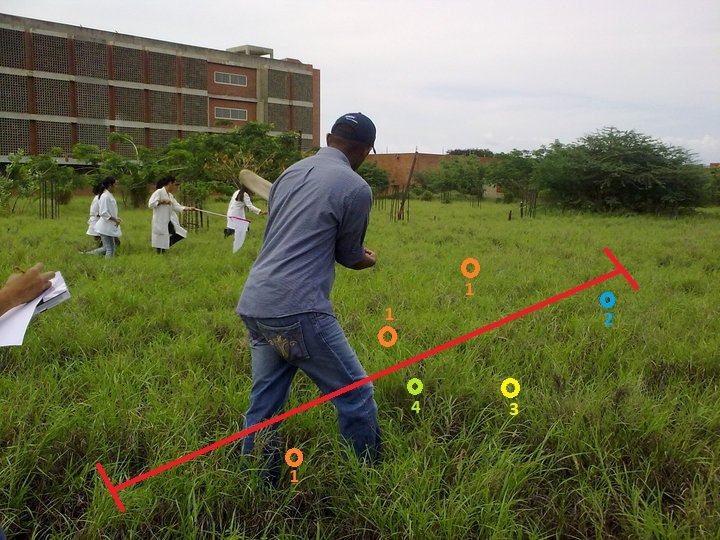
One of the population calculations for a species is the Relative abundance, a statistical tool with which we can measure the size of a species in a population! the formula is expressed pi=ni/N where pi: is the probability of being found the species in the set, ni: is the number of times the species was registered, N: is the total number of registered individuals of all species !🕵️♀️🕵️♂️👨🏫
Um dos cálculos populacionais para uma espécie é a abundância relativa, uma ferramenta estatística com a qual podemos medir o tamanho de uma espécie em uma população! a fórmula é expressa pi=ni/N onde pi: é a probabilidade de ser encontrada a espécie no conjunto, ni: é o número de vezes que a espécie foi registrada, N: é o número total de indivíduos registrados de todas as espécies!🤯😬🥽🥼

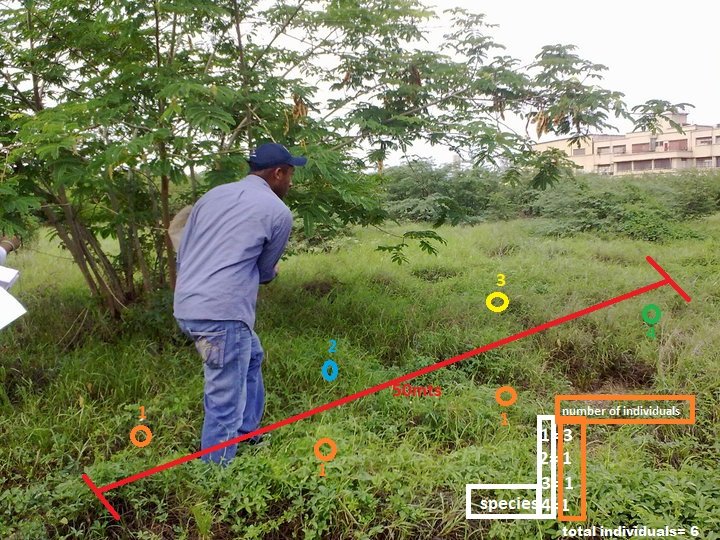
To understand the relative abundance we must understand the meaning of each letter in the formula, for example in the photo my partner is walking in an imaginary straight line (transect), and is capturing butterflies, each circle with a different color represents a different species, for what if we capture the A.vanillae species 3 individuals (orange), 1 individual (blue) of colepterus, 1 individual (yellow) bird, 1 caterpillar individual (green)! we captured 6 individuals of 4 different species! to know the probability of meeting our butterfly then pi = ni (individuals of our butterfly) 3 / the individuals captured all N = 0.5 this tells us that we have a probability of 0.5 of getting an A. vanillae every 50 meters !🤓🤓👨🙋♂️
Para entender a abundância relativa, devemos entender o significado de cada letra na fórmula, por exemplo, na foto meu parceiro está caminhando em uma linha reta imaginária (transecto), e está capturando borboletas, cada círculo com uma cor diferente representa uma espécie diferente , e se capturarmos a espécie A.vanillae 3 indivíduos (laranja), 1 indivíduo (azul) de colepterus, 1 indivíduo (amarelo) ave, 1 indivíduo orugal (verde)! capturamos 6 indivíduos de 4 espécies diferentes! para saber a probabilidade de encontrar nossa borboleta então pi = ni (indivíduos de nossa borboleta) 3 / os indivíduos capturaram todos N = 0,5 isso nos diz que temos uma probabilidade de 0,5 de obter um A. vanillae a cada 50 metros!🤔🤔

SAMPLING BY QUADRANT2️⃣🌿🌾
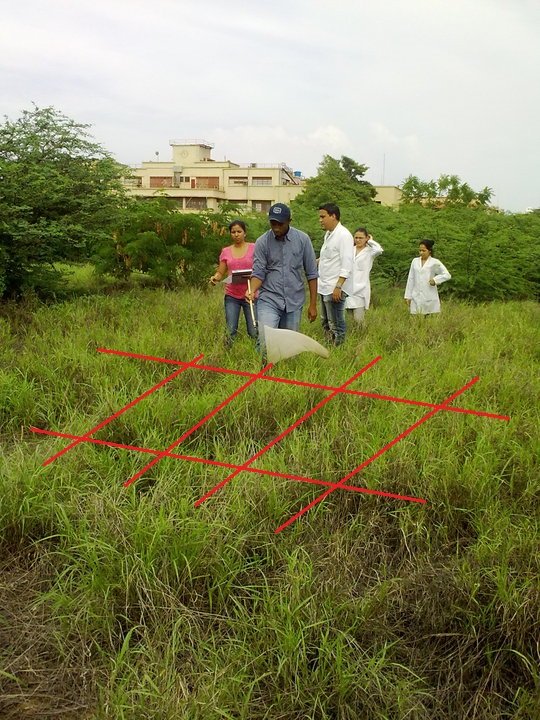
Another ecological technique used for the study of populations is the quadrant, it is a method used many times for studies of vegetations (because they are sedentary species without movements), it is much more homogeneous and yields less edge impacts compared to the transects, in this In case material such as thick threads or wood is used to define our quadrant, here we do not create anything imaginary!🤔🤔
Outra técnica ecológica utilizada para o estudo de populações é o quadrante, é um método utilizado muitas vezes para estudos de vegetações (por serem espécies sedentárias sem movimentos), é muito mais homogêneo e produz menos impactos de borda em relação aos transectos, em Neste caso, materiais como fios grossos ou madeira são usados para definir nosso quadrante, aqui não criamos nada imaginário!

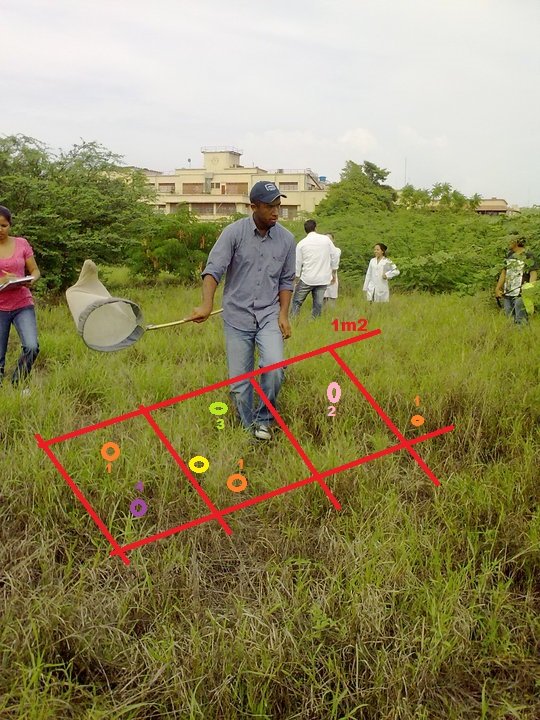
With these population study techniques we can also calculate the frequency of the species! is defined as the probability of finding a species in a particular sample unit!😮😮
Com essas técnicas de estudo populacional também podemos calcular a frequência das espécies! é definido como a probabilidade de encontrar uma espécie em uma determinada unidade de amostra!😶😶

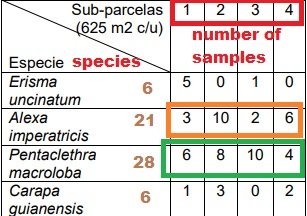
The frequency parameters can be defined as: common, uncommon, rare, very rare! If we look at the table we can see that 4 samplings were made, 4 different species of animals were identified (plants, insects, birds, mammals) if we add the number of species collected in all the samples we obtain: species 1 = 6 individuals, the species 2 = 21 individuals, species 3 = 28 individuals, species 4 = 6! our frequency would be species 3 is the most abundant with 28, species 2 is common, the remaining others are rare! If we could register a species with 4 or 3 individuals it would be rare! in this way we can create a statistical pattern to know the frequency of a species in a study!✅1️⃣2️⃣
Os parâmetros de frequência podem ser definidos como: comuns, incomuns, raros, muito raros! Se observarmos na tabela podemos ver que foram feitas 4 amostragens, foram identificadas 4 espécies diferentes de animais (plantas, insetos, pássaros, mamíferos) se somarmos a quantidade de espécies coletadas em todas as amostras que obtemos: espécie 1 = 6 indivíduos, a espécie 2 = 21 indivíduos, espécie 3 = 28 indivíduos, espécie 4 = 6! nossa frequência seria a espécie 3 é a mais abundante com 28, a espécie 2 é comum, as demais são raras! Se pudéssemos registrar uma espécie com 4 ou 3 indivíduos, seria raro! desta forma, podemos criar um padrão estatístico para saber a frequência de uma espécie em um estudo!3️⃣4️⃣5️⃣

LABORATORY3️⃣🌿🌾
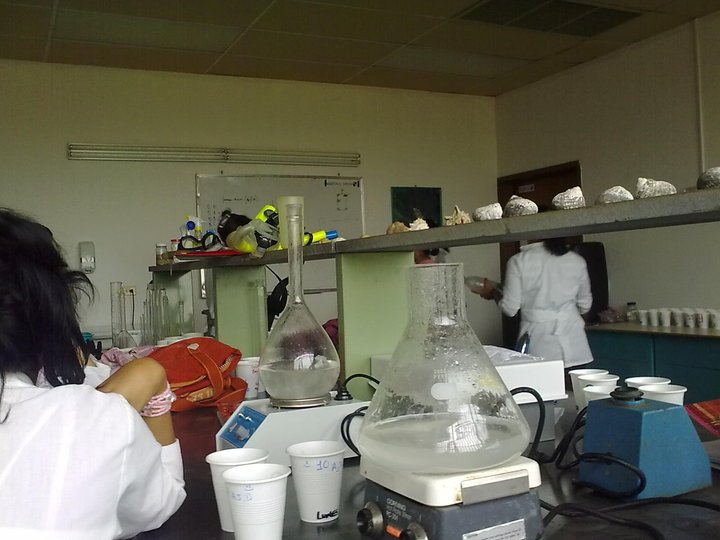
Once our insects are collected, we go to the laboratory to separate them by species! For this we use diluted formaldehyde, this will help to kill them without causing any trauma, simply put them to sleep but with a high concentration so as not to wake up! Be very careful when handling the formaldehyde, it evaporates and if we breathe it directly we can feel a severe headache or faint!👍👃
Uma vez que nossos insetos são coletados, vamos ao laboratório para separá-los por espécie! Para isso usamos formaldeído diluído, isso vai ajudar a matá-los sem causar nenhum trauma, basta colocá-los para dormir mas com uma concentração elevada para não acordar! Tenha muito cuidado ao manusear o formaldeído, ele evapora e se o respirarmos diretamente podemos sentir uma forte dor de cabeça ou desmaiar!👨⚕️👨🏫👨🔬👨💻

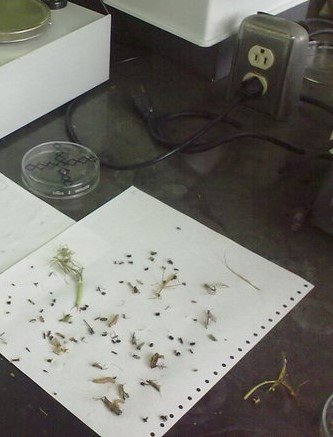
Once the dead insects are separated by species on a blank sheet! to later take them to a macroscope and obtain better details when some species cannot be identified! then we carry out the respective calculations!😮😮
Uma vez que os insetos mortos são separados por espécies em uma folha em branco! para depois levá-los a um macroscópio e obter melhores detalhes quando alguma espécie não puder ser identificada! então fazemos os respectivos cálculos!😮😮🤔

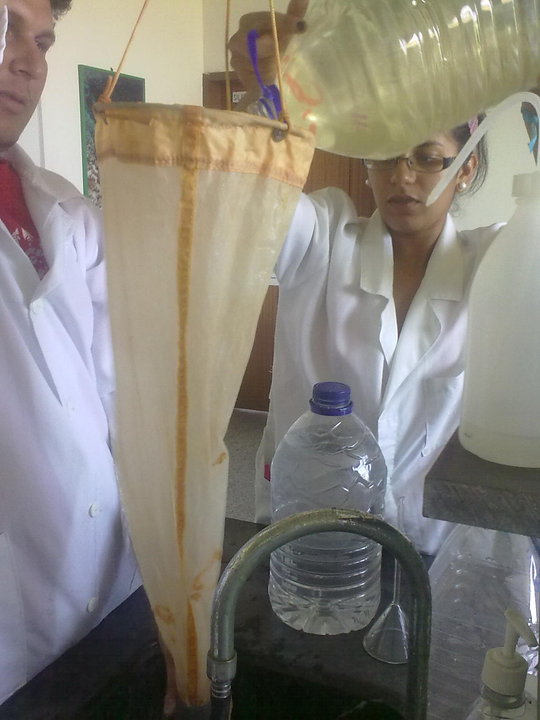
To study small organisms like Branchiopoda we fill plastic containers with the water that we are going to study, it can be a puddle, lake etc, any body of water! Then we filter it through a cone with cloth material that at the end has a filter, it lets the water pass but smaller organisms are filtered! This ecological technique is used to study small organisms in growth phases!⚗🔬🔬
Para estudar pequenos organismos como Branchiopoda enchemos recipientes de plástico com a água que vamos estudar, pode ser uma poça, lago etc, qualquer corpo de água! Depois a filtramos através de um cone com um tecido que no final tem um filtro, deixa a água passar mas os organismos menores são filtrados! Esta técnica ecológica é usada para estudar pequenos organismos em fases de crescimento!👀👀

Agraulis vanillae🦋🦋🦋
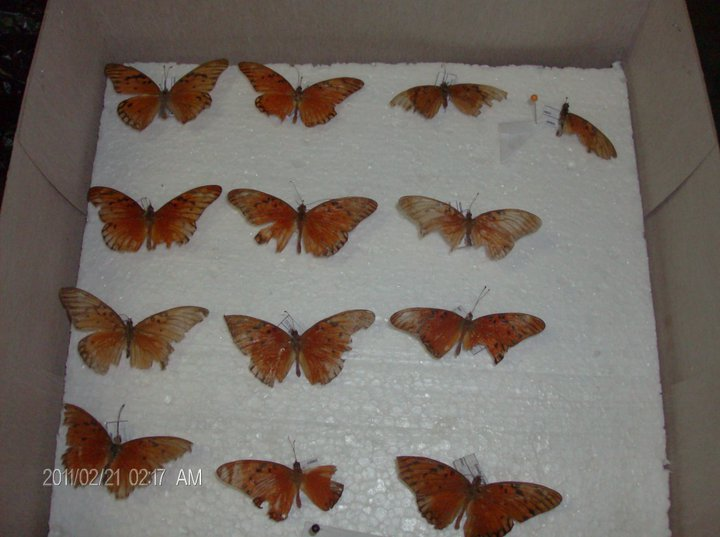
We can observe adult Agraulis vanillae dorsal view, it has orange lower wings with dark brown semi-curved lines and dark brown dots, semi-wavy edge, upper wings with wavy edges and orange color with orange points with black edge. They have been observed making migrations and are occasionally sighted in the Gulf of Mexico. Their migration in Florida is well documented. The first migration is of butterflies flying north in the spring and the second south in the fall. Its distribution extends to South America. Agraulis vanillae can become locally abundant in grasslands and crops in dry or semi-arid regions. In the state of Mérida, in Venezuela, it has been indicated as a cause of magnitude damage to passion fruit plants (Passiflora edulis).
https://www.acguanacaste.ac.cr/paginas-de-especies/insectos/104-nymphalidae/3507-i-agraulis-vanillae-i-nymphalidae
Pode-se observar Agraulis vanillae adulto em vista dorsal, possui asas inferiores alaranjadas com linhas semicurvadas marrom-escuras e pontos marrom-escuros, borda semi-ondulada, asas superiores com bordas onduladas e de cor laranja com pontas laranja com borda preta. Eles foram observados fazendo migrações e ocasionalmente são avistados no Golfo do México. Sua migração na Flórida está bem documentada. A primeira migração é de borboletas voando para o norte na primavera e a segunda para o sul no outono. Sua distribuição se estende à América do Sul. Agraulis vanillae pode se tornar localmente abundante em pastagens e plantações em regiões secas ou semi-áridas. No estado de Mérida, na Venezuela, tem sido apontada como causa de danos de magnitude ao maracujá (Passiflora edulis).

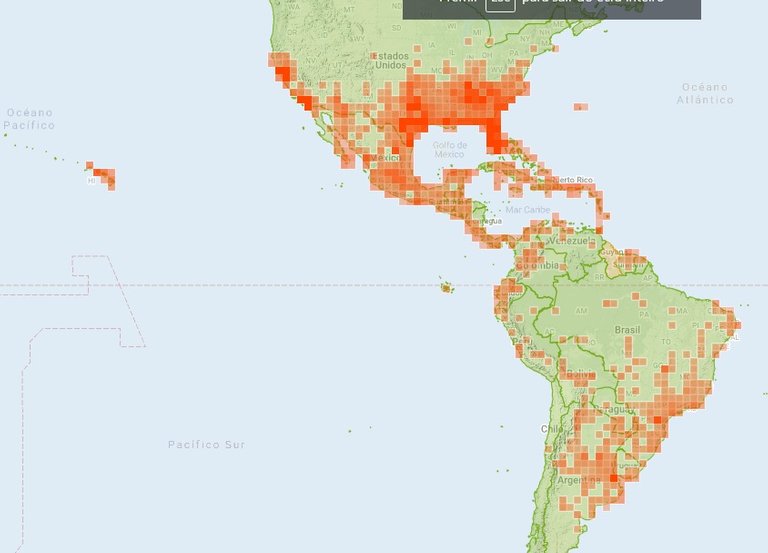
https://www.argentinat.org/taxa/49150-Agraulis-vanillae

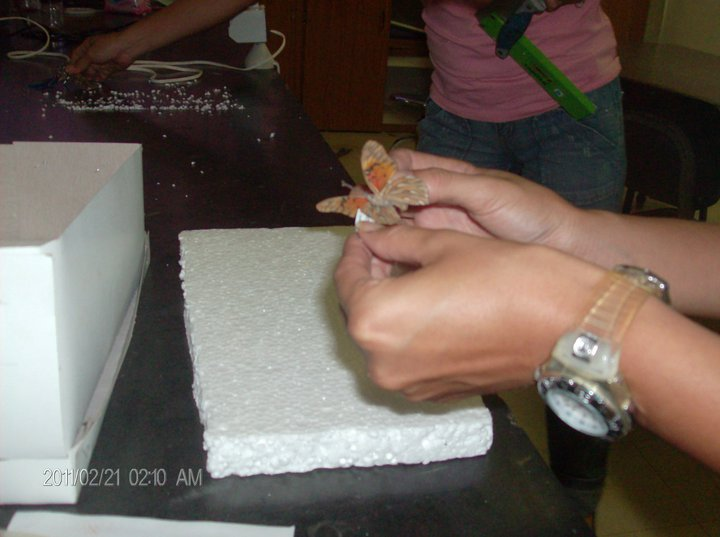
Our small project was about surveying and calculating populations of Agraulis vanillae, in order not to lose our catches we decided to donate them to the L.U.Z entomology laboratory for scientific purposes, and thus learn a little about the technique of mounting insects with pins!🤩🤩
Nosso pequeno projeto consistia em levantamento e cálculo de populações de Agraulis vanillae, para não perdermos nossas capturas decidimos doá-las ao laboratório de entomologia L.U.Z para fins científicos, e assim aprender um pouco sobre a técnica de montagem de insetos com alfinetes!🤔🤔🥼🥽


The photos in the field were taken by several colleagues from the group! When studying the ecology classroom, the photos of the butterflies are my property! the information not quoted is from my intellect, the rest have their respective quotes!

I would like to invite you to follow the @discovery-it community, supporting us together also means growing!
THANKS🎈🎋🎄🎍
OBRIGADO🧡💥💞

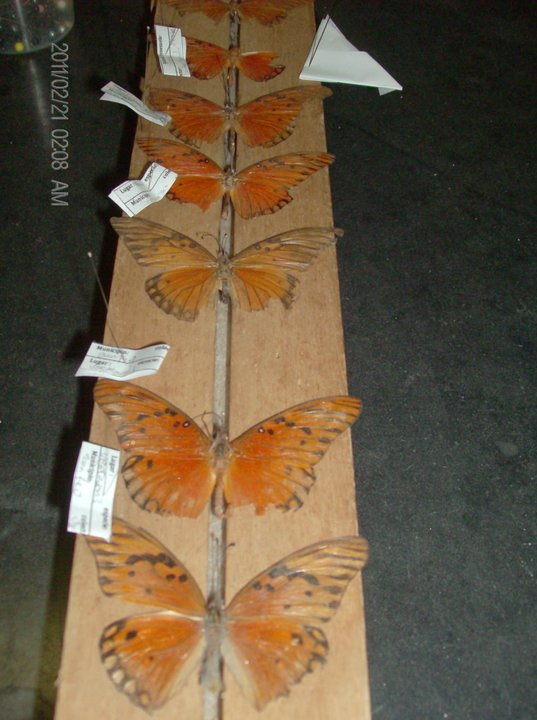
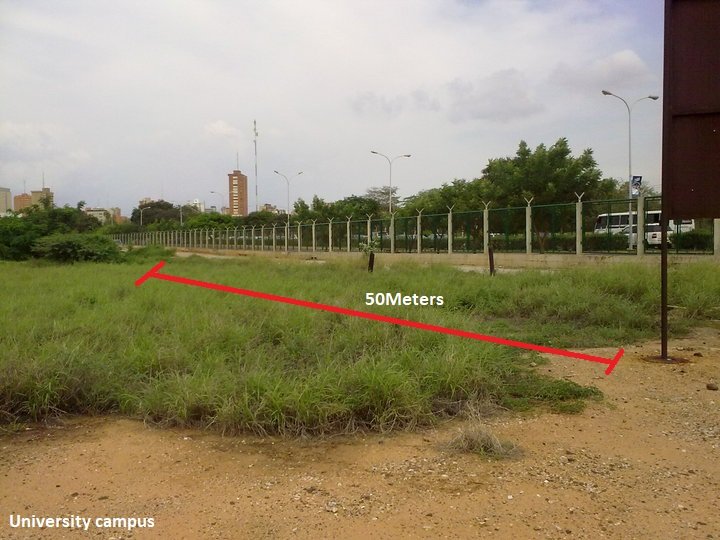

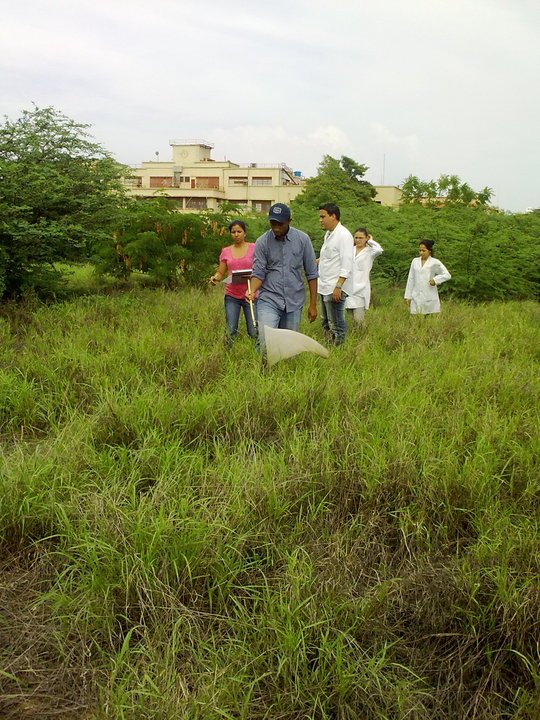


























That is a cool method to quantifiy a species, wish we could something like that back when I was still study ecology. Instead we did this thing where we would put a trap with a cup with a bit of water, bury it, identify the species. Then divided the number of individuals of said species over the total number of captured insects.
If once I also applied this technique! something similar to capture arachnids, you bury a jar you make a trap and they fall there!
We appreciate your work and your post has been manually curated by @nelinoeva on behalf of Amazing Nature Community. Keep up the good work!